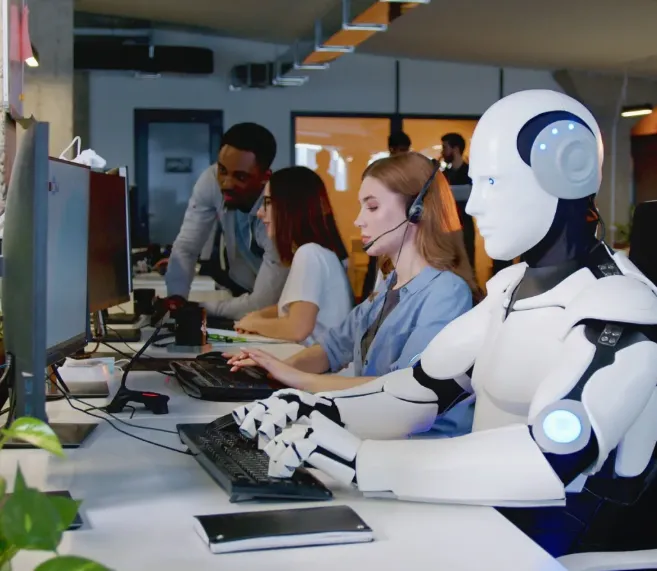As artificial intelligence (AI) moves from being a buzzword to an essential tool, businesses must shift their understanding of what it means to build a high-performing team. The future of work isn’t just about humans; it also includes AI, which is now emerging as an active member of many teams. AI isn’t replacing workers but enhancing the capabilities of the workforce, improving efficiency, and unlocking new opportunities.
The conventional workplace is undergoing a transformation, thanks to the rise of AI-powered digital agents. These agents are becoming integrated colleagues, seamlessly supporting workflows and solving problems, from automating routine tasks to improving decision-making in areas like customer support, legal processes, and human resources.
According to a study by Guidant Global, 33% of organizations reduced permanent headcount last year, while more than 80% increased their reliance on specialized contractors. Moreover, nearly 90% plan to expand contingent workforce capabilities. This shift towards a more flexible and diverse workforce, which includes both humans and AI, requires companies to rethink how they operate. AI is here to help—not replace—by offering new efficiencies that drive productivity and innovation.
AI Augments, Not Replaces
There’s understandable anxiety surrounding job displacement, but AI is not here to take over human roles. Instead, AI tools are being used to automate mundane tasks, accelerate data processing, and help improve decision-making. In HR, for example, 88% of companies use AI-powered chatbots, while 78% leverage AI for skill gap analysis and learning recommendations. These tools enhance efficiency, freeing up human workers to focus on more strategic and creative tasks.
By automating repetitive, time-consuming tasks, AI not only boosts productivity but also allows employees to engage in higher-value work, such as problem-solving, leadership, and relationship-building. But integrating AI successfully requires a deliberate investment in upskilling employees, preparing them to collaborate effectively with AI agents in their evolving roles.
While AI brings cost-saving benefits, organizations that view AI as a digital colleague—rather than just a tool—report quicker delivery times, better accuracy, and increased productivity. However, realizing these benefits isn’t as simple as just deploying AI; it requires a fundamental shift in mindset and management strategies.
Managing Hybrid Teams: A New Leadership Approach
As AI becomes an integral part of teams, the role of managers is also changing. Leaders need to learn how to manage hybrid teams that combine human and digital talent. This includes planning team structures, allocating budgets, adjusting learning and development (L&D) strategies, and forecasting workloads with AI’s capabilities in mind.
Far from eliminating leadership roles, this shift provides an opportunity for managers to future-proof their skill sets. Effective leadership in this new era will require a deep understanding of AI’s capabilities, its limitations, and when human expertise is needed to guide AI’s output. As AI continues to contribute to team goals, managers will need to constantly evaluate its performance, ensuring that digital agents complement rather than replace human oversight.
Due Diligence for Digital Workers
Just as businesses carefully assess new hires, AI tools should undergo thorough evaluation before being integrated into workflows. Organizations must ask critical questions: Does the AI system solve a specific problem? Does it integrate smoothly with existing systems? Can it actually enhance, rather than complicate, team performance?
The best approach is to pilot AI solutions before scaling them. Leaders should identify specific use cases, test AI in real-world scenarios, collect feedback from team members, and iterate on the solution. This process ensures AI is properly vetted, much like hiring a new team member would be.
Governance, Ethics, and Compliance in the Age of AI
As AI becomes more embedded in everyday business operations, companies must prioritize governance. Digital workers should adhere to the same standards of accountability, compliance, and ethical behavior as their human counterparts. This is especially critical for global organizations, which must navigate both international regulations and region-specific laws.
For example, the EU’s AI Act imposes strict requirements on high-risk AI applications, including transparency, oversight, and safety standards. In contrast, the U.S. lacks centralized federal AI regulation, leaving companies to grapple with sector-specific and state-level laws. This means that successful governance will require cross-functional collaboration across legal, HR, IT, and procurement teams to ensure compliance and secure use of AI systems.
Building a Future-Ready Workforce
AI is already reshaping the workforce, and organizations are choosing different paths when integrating these technologies. Some businesses are proactively incorporating AI into their teams, embracing hybrid work models that combine full-time employees with flexible workers and AI agents. Others are still hesitant, bogged down by outdated workforce models and uncertainty about how to manage this new digital team member.
The key differentiator between successful organizations and those that struggle is preparation. AI offers the potential to close performance gaps, but businesses must be ready to fully integrate and support AI solutions. In today’s rapidly evolving market, technical skills in areas like cybersecurity, AI, and cloud computing are in high demand, and AI can either exacerbate skill gaps or help fill them—depending on how it’s deployed.
Like any other colleague, AI agents need clear objectives, accountability, and continuous performance reviews. They also need human team members who are capable of collaborating effectively and leaders who understand how to maximize their impact.
The integration of AI into the workforce isn’t just about adding technology; it’s about enhancing what’s already working and taking it to the next level. Employees are ready to adapt to this new co-worker, but they need reassurance that their contributions are just as valuable as ever. AI is here to stay, and businesses must embrace its role in creating new team structures and processes. It’s clear that working alongside AI systems is the next great challenge and opportunity for organizations.







